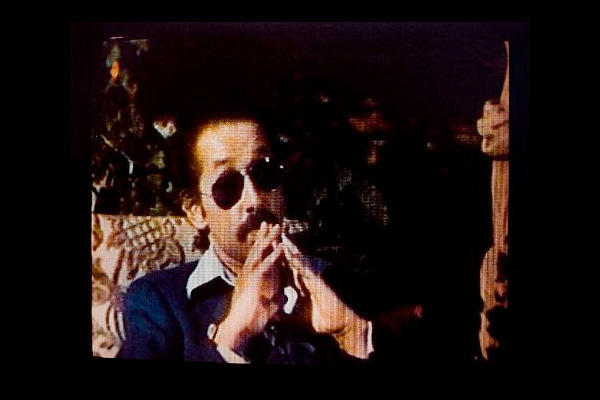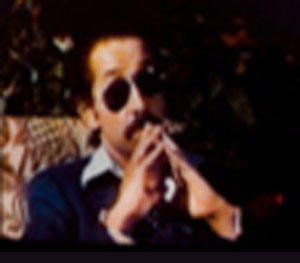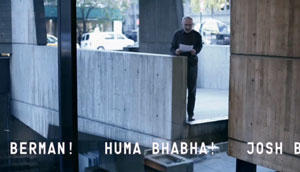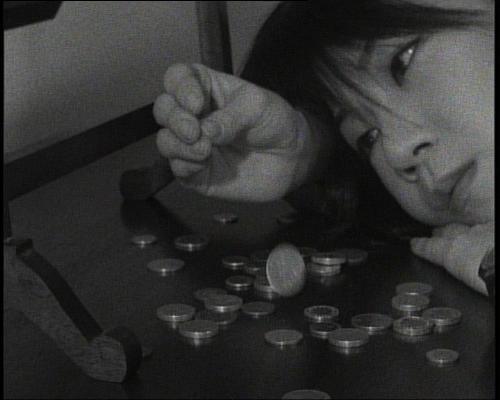Each year, Bidoun Projects presents a series of new video programs with the aim of exploring various thematic concerns and highlighting video art practice in and around the Middle East.
The programs are launched at Art Dubai (March 17–20, 2010) in the Art Park–an underground space for talks, film and video–and then travel on throughout 2010 to venues in the region and beyond.
This year’s programs are curated by Bidoun and guest curators Masoud Amralla Al Ali , Aram Moshayedi , and the duo of Özge Ersoy and Sohrab Mohebbi.

Program One: Cloudy Head
Curated by Bidoun
Running time: approximately 35’
Bidoun Projects’s latest video program brings together works that reference the power of collectively produced codes of communication and highlight the artist’s ability to tap into this power and make it their own. The assembled works engage the hyper-expressive, sometimes hysterical, voices born of these conditions.
The dense streets of a megalopolis are evoked in a percussive translation of street talk, while the romantic promise of YouTube as a venue for self-representation is interrogated through clips of body builders that relate to one artist’s awareness of his own agenda. The thin line between absurdist theater and political demonstration points to the failure of video itself, and Ravel’s Boléro is rendered magical in the presence of a Brazilian street prophet. Somewhere between investigation and homage, polemic and testimony, these videos attest to the failure and eloquence of collective languages as well as their transformative power.
Deaf Countries — Eyad Hamam
2009, 2’; courtesy of the artist
Red, Green, Black and White Indians — Sobhi Al Zobaidi
2007, 43”; courtesy of the artist
Cloudy Head — Justine Triet
2009, 4’58”; courtesy of the artist
Camaraderie — Mahmoud Khaled
2009, 10’30”; courtesy of the artist
80 Million — Eslam Zeen El Abedeen and Mohamed Zayan
2009, 3’41”; courtesy of the artists
Nástio’s Manifesto — Nástio Mosquito
2008, 4’8”; courtesy of the artist
Arabic Home Interiors: An Introduction — Vartan Avakian
2009, 3’40”; commissioned by Tokyo Wonder Site, courtesy of the artist
Adhan — Haroon Mirza
2009 , 4’30”; courtesy of the artist and Lisson Gallery

Program Two: Hollywood Elegies
Curated by Aram Moshayedi
Running time: approximately 50’
“Hollywood Elegies” is the title of one of many pieces of writing Bertolt Brecht composed while living in Los Angeles, from 1941 to 1947. Brecht’s poetry from this period reflected his dissatisfaction with the social and cultural conditions of his newfound home in exile. The six stanzas that comprise this particular text describe the overwhelming presence of the Hollywood industry in the world around him. There is the sense from these passages that Hollywood existed for him less as a specific geography and more as a disorienting state we all experience, no matter the time or place.
The videos that make up this program may or may not refer directly to Hollywood as a location, but in them we find propositions that relate, in sideways or direct fashion, to the current conditions of production, exhibition, and distribution throughout cultural realms. While Hollywood is no longer regarded as a dream factory, its mechanics, for better or worse, still seem to operate.
Shoving — Hirsch Perlman
1994, 12’; courtesy of the artist and Blum & Poe, Los Angeles
Untitled (Ladera Heights) — Drew Heitzler
2007, 46”; Courtesy of the artist; Blum & Poe, Los Angeles
The Dictator — David Lamelas and Hildegarde Duane
1978, 15’; courtesy of the artists
NastyNets.com sent you a video postcard — Nasty Nets
2010, 6’; courtesy of the artists
The Cockpit — Tracey Rose
2008, 3’; courtesy of the artist and DBA Christian Haye, New York
Instructional Film — Walead Beshty
2010, 10’ (excerpt); courtesy of the artist and Wallspace, New York
Untitled — Jordan Wolfson
2007, 3’; courtesy of the artist and Johann König, Berlin
Dimples — JMS and Miljohn Ruperto
2010, screenplay (a text supplement); courtesy of the artists and Thomas Solomon Gallery, Los Angeles

Program Three: Strike a Pose
Curated by Özge Ersoy and Sohrab Mohebbi
Running time: approximately 35’
Support structures for the arts—biennials, art fairs, and global museums—are more ambitious these days than ever. With the unprecedented increase of interest in contemporary art and the controversial expansion of the art world into a new universal class, without essentialist boundaries or regional claims, more and more media outlets are covering art matters.
The role of the mass media on contemporary society has often been viewed with suspicion by artists. However, contemporary art now seems to adapt to mass-media semiotics without contesting their set standards and formats. Is the art community simply testifying to the invincible power of the spectacle and the regime of the visual? Or is it taking its time to shape its strategies and experimenting with newly discovered possibilities, reframing its representation for a more inclusive viewership? How can art practitioners contribute to the formation of a mass-media representational format specific to the arts? Furthermore, can they contribute to the formation of a lexicon that uses mass media in more engaging modes, as opposed to only establishing a critical distance?
This program comprises a selection of video clips in a variety of formats including news, updates, behind-the-scenes shots, artist interviews, and promotional clips; together these investigate the limits and the possibilities that the mass-media video genre can offer to the art community. The program includes—among others—Twitter with Marina Abramović; Francesco Bonami and Gary Carrion-Murayari announcing Whitney 2010 artists; Tirdad Zolghadr, Lamya Gargash and Dr. Lamees Hamdan on the UAE Pavilion in the Venice Biennale; a Vernissage report on the 11th Istanbul Biennial; and excerpts from the half-hour television shows created by Circular File and commissioned by Performa.
The List: Francesco Bonami and Gary Carrion-Murayari announcing Whitney 2010 artists — Pierce Jackson and the Whitney Museum of American Art
courtesy of the Whitney Museum of American Art
2010, 1’42’’
Venice Biennale: UAE Pavilion — Bloomberg Tate Shots
courtesy of Tate
2009, 3’51’’
30 Seconds at MoMA: Staff—Tamsin Nutter — Thilo Hoffmann
Commissiobed by and courtesy of the Museum of Modern Art, New York
2008, 53’’
Rudolf Stingel. LIVE at Neue Nationalgalerie Berlin — VernissageTV
courtesy of VernissageTV
2010, 5’58’’MoMA Doug Aitken: Sleepwalkers [60-second trailer] — Doug Aitken
courtesy of the artist and the Museum of Modern Art, New York
2006, 1’02’’11th International Istanbul Biennale 2009 — VernissageTV
courtesy of VernissageTV
2009, 7’46’’30 Seconds at MoMA: Staff—Andy Haas — Thilo Hoffmann
courtesy of the Museum of Modern Art, New York
2008, 0’59’’Twitter With… Marina Abramović — Bloomberg Tate Shots
courtesy of Tate
2009, 7’ 20’’Circular File Channel, Episode 1 (2005) — Performa.
commissioned by and original presented by Performa 09; courtesy of the artists and Performa
2009, 4’11’’ (excerpt)

*Program Four: Exploding Nostalgia
*Curated by Masoud Amralla Al Ali and Antonia Carver
Over the past decade, there has been an explosion in short filmmaking in the UAE, driven in part by initiatives such as the Emirates Film Competition and the Gulf Film Festival, both founded by curator Masoud Amralla Al Ali. Although most continue to see themselves as filmmakers rather than artists, some Emirati directors have begun pushing the medium and their subjects, often making use of surreal, experimental imagery and drawing as much on traditions of oral poetry as on existing cinematic styles in the region. The films in this program reflect early efforts as well as more recent films, and range from nostalgic, whimsical tales from the northern emirates to introspective studies, via abstract illustration; they are bound together by their combined reflection on today’s connections to the traditions and landscape of the UAE.
Haresat Al Ma'a (The Water Guard) — Waleed Al Shehhi
2007, 11’29”; courtesy of the filmmaker and Reflective Group of Art Production
Mirror — Saleh Karama Al Amri
2003, 3’12”; courtesy of the artist
Wajeh Alilq (Stuck Face) — Manal Ali Bin Amro
2007, 6’03”; courtesy of the artist
My Way — Khalil Abdulwahed Abdulrahman
2005, 6’50”; courtesy of the artist
Amal’s Cloud — Rawia Abdullah
2009, 9’18”; courtesy of the artist
Video #2 — Ahmed Mohammed Sharief
2003, 5’; courtesy of the artist